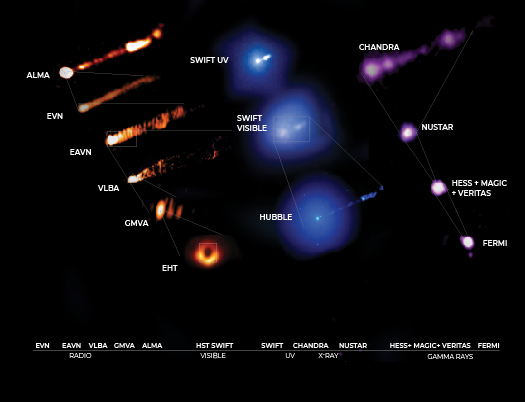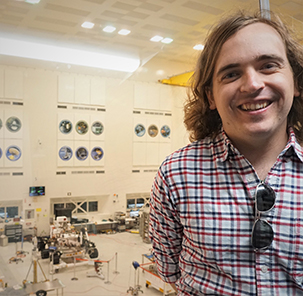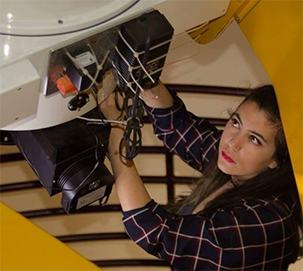Quasars & Active Galaxies
Chandra's Indirect Glance into the Early Universe: Merging Dwarf Galaxies and their AGN
We are pleased to welcome Marko Mićić as a guest blogger. Marko led the study that is the subject of our latest press release [link to PR]. He graduated from the University of Belgrade, Serbia, with a degree in Astronomy and Astrophysics, in 2018. The same year he started a Ph.D. at the University of Alabama, and has been working under Dr. Jimmy Irwin's supervision since then. His research interests include evolution of low-mass galaxies, AGN content of low-mass galaxies, intermediate-mass black holes and gravitational lenses.
Galaxies are made up of billions of stars, interstellar gas and dust, and large amounts of dark matter. Every (or almost every) galaxy is expected to host a supermassive black hole in its center. Galaxies and their central black holes grow and evolve together predominantly through mergers; smaller objects merge to create larger ones over time. However, the earliest stages of galaxy evolution involving the mergers of the first galaxies are poorly understood. It is unclear how the first mergers affected the morphology of ancient galaxies and their star formation. We also do not know how massive the first black holes were that inhabited the first galaxies, nor how the first mergers influenced their ability to accrete – pull in – material.
It is challenging to answer these important questions because the first mergers are too distant and faint to be directly observed. One way to overcome this issue is to look for local analogs. In other words, we need to find pairs of small, dwarf galaxies that have had very quiet lives, with almost no mergers, that have only recently met and started interacting. Such galaxies have experienced little to no evolution so they are analogs of distant, ancient galaxies, and observations of their mergers would represent the local case study that illustrates the hierarchical growth of structures in the early Universe. Their central black holes are also expected not to have grown much and preserve information about primordial seeds, potentially holding the key to resolving the outstanding problem of the origin of supermassive black holes.
"X-ray Magnifying Glass" Enhances View of Distant Black Holes
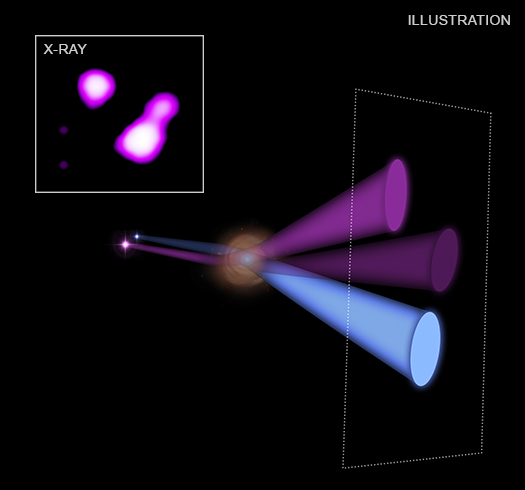
Gravitationally-Lensed System MG B2016+112
Credit: Illustration: NASA/CXC/M. Weiss; X-ray (inset): NASA/CXC/SAO/D. Schwartz et al.
A new technique using NASA's Chandra X-ray Observatory has allowed astronomers to obtain an unprecedented look at a black hole system in the early Universe, as reported in our latest press release. This is providing a way for astronomers to look at faint and distant X-ray objects in more detail than had previously been possible.
Astronomers used an alignment in space that shows "gravitational lensing" of light from two objects that are nearly 12 billion light years away. An artist's illustration in the main part of this graphic shows how the paths of light from these distant objects are bent and amplified by a galaxy along the line of sight between Earth and the objects.
Telescopes Unite in Unprecedented Observations of Famous Black Hole
Your browser does not support the video tag.
![]() More Information
More Information
Video compilation: NASA/GSFC/SVS/M.Subbarao & NASA/CXC/SAO/A.Jubett
In April 2019, scientists released the first image of a black hole in the galaxy M87 using the Event Horizon Telescope (EHT). This supermassive black hole weighs 6.5 billion times the mass of the sun and is located at the center of M87, about 55 million light-years from Earth.
The supermassive black hole is powering jets of particles that travel at almost the speed of light, as described in our latest press release. These jets produce light spanning the entire electromagnetic spectrum, from radio waves to visible light to gamma rays.
To gain crucial insight into the black hole's properties and help interpret the EHT image, scientists coordinated observations with 19 of the world's most powerful telescopes on the ground and in space, collecting light from across the spectrum. This is the largest simultaneous observing campaign ever undertaken on a supermassive black hole with jets.
The NASA telescopes involved in this observing campaign included the Chandra X-ray Observatory, Hubble Space Telescope, Neil Gehrels Swift Observatory, the Nuclear Spectroscopic Telescope Array (NuSTAR), and the Fermi Gamma-ray Space Telescope.
From NASA’s Jet Propulsion Laboratory to the Universe's Earliest Jet propulsion Laboratory
We are happy to welcome Thomas Connor as a guest blogger today. Thomas is a NASA Postdoctoral Fellow at NASA Jet Propulsion Laboratory (JPL) in Pasadena, California and the author of a paper that is the subject of our most recent press release. He completed his undergraduate degree at Case Western Reserve University and earned his doctorate from Michigan State University. Prior to starting at JPL, Dr. Connor was a postdoctoral fellow at the Observatories of the Carnegie Institution for Science. His scientific interests include black holes in the dawn of the Universe, the evolution of galaxies in dense environments, and the structure of the Cosmic Web.
Most of the fundamental questions of astronomy relate to how the universe as we observe it was assembled. From stars and planets to nebulae and galaxies, many of the investigations of astronomy come down to crafting a coherent narrative of formation and evolution. Currently, that narrative is struggling to be built in the early universe, where supermassive black holes with masses a billion times that of the Sun are seen only a few hundred million years after the Big Bang. The challenge here is that, while we can model ways for such massive objects to form and grow, compressing that growth into such a short time scale is much more difficult. As an analogy, it is not surprising that an author can write a novel, but it would be astounding if she could do so in only one day.
Black holes grow by eating their surroundings, but, contrary to the typical depiction of these objects, they do not suck. Rather, they slowly nibble their way through an "accretion disk," an orbiting disk of gas that acts as a buffet for the black hole. As more gas makes its way inward, this disk will get hot from all of the friction of particles rubbing together, and it will start glowing like a hot coal. This bright light will act like a strong wind, pushing away further gas from replenishing the disk. Thus, the black hole's feeding is self-limiting — if it eats too fast, it won't be able to restock the buffet, and so it will have to slow down. This fundamental limit is why we are puzzled at how such massive black holes can exist so early.
The Symbiosis of Powerful Quasar Jets and Their Bright Coronas

Shifu Zhu
Shifu Zhu, a 5th-year graduate student of Astronomy & Astrophysics at Pennsylvania State University, is our guest blogger for this post. He received his B.S. in Astronomy from the University of Science and Technology of China (USTC) in 2013. He received his M.S. in Astrophysics from USTC in 2016.
“So, the answer to the nature of the X-ray emission from radio-loud quasars is simpler than we previously had thought,” I said to myself after staring for a while at our new correlations between how bright radio-loud quasars are in X-ray and ultraviolet light.
The term “quasar” was originally coined for bright radio sources that look like stars in visible-light images, i.e., quasi-stellar radio sources. Shortly after their discovery, researchers realized that quasars are supermassive black holes (with masses of millions to billions of times that of the Sun) feeding on material that is gravitationally attracted to them. Notably, despite this strong gravitational attraction, some material can also be ejected in powerful jets, narrow streams of material shooting away from the supermassive black hole in opposite directions. These jets are fueled by material in an “accretion disk” falling towards the black hole.
Happy Little Accidents: The Happenstance Finding of Obscured Growing Supermassive Black Holes with Chandra
We are delighted to welcome Erini Lambrides from Johns Hopkins University (JHU) in Baltimore Maryland as a guest blogger. She is the first author of a paper in the Astrophysical Journal that is the subject of our latest press release. Erini is a PhD candidate at JHU in the Department of Physics and Astronomy and will be defending her thesis next year. Prior to starting her PhD, she spent a year as a research assistant at Gemini Observatory North, and a year as a research assistant at the American Museum of Natural History in NYC. She got her BS with Honors in Physics at the University of Rochester. She was awarded a NASA Maryland Space Grant Fellowship to fund her PhD and outreach efforts. Her research is focused on quantifying the extent and impact of AGN-host galaxy co-evolution.
When one normally thinks of the scientific method, the following mantra rooted in elementary school days comes to mind: The Question, The Research, The Hypothesis, The Data, The Conclusion. Neatly lined, linear steps that seemingly underpin the entirety of humanity’s quest for knowledge about our physical world. I learned this when I was ten years old, but nearly twenty years later, as I trundle along my own scientific journey, I’ve learned that the steps of the scientific method more resemble an M.C. Escher painting.
My group and I have recently completed work on a peculiar class of astrophysical objects: growing supermassive black holes that are embedded in a thick cocoon of gas and dust. This work is exciting because we discovered that this particularly difficult-to-observe class of objects can be detected in greater numbers than previously thought. However, when I started this work, my goal was not to find these objects, nor was it even about this class of objects!
Astronomers Revisit First 'Einstein Ring' In Archival Data
This article appeared on NASA.gov, written by NASA public information officer Elizabeth Landeau, based on a press release from Keck Observatory.
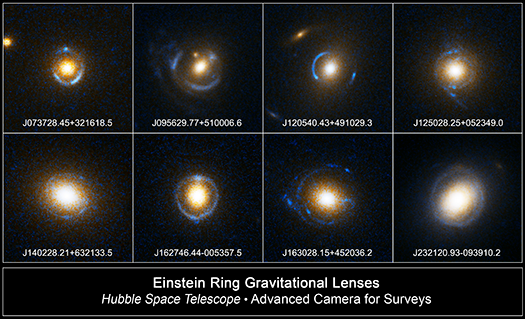
Examples of Einstein ring gravitational lenses taken with the Hubble Space Telescope.
Credit: NASA/ESA/SLACS Survey Team: A. Bolton (Harvard/Smithsonian), S. Burles (MIT), L. Koopmans (Kapteyn), T.Treu (UCSB), L. Moustakas (JPL/Caltech)
Determined to find a needle in a cosmic haystack, a pair of astronomers time traveled through archives of old data from W. M. Keck Observatory on Mauankea in Hawaii and old X-ray data from NASA’s Chandra X-ray Observatory to unlock a mystery surrounding a bright, lensed, heavily obscured quasar.
This celestial object, which is an active galaxy emitting brilliant amounts of energy due to a black hole devouring material, is an exciting object in itself. Finding one that is gravitationally lensed, making it appear brighter and larger, is exceptionally exciting. While slightly over 200 lensed unobscured quasars are currently known, the number of lensed obscured quasars discovered is in the single digits. This is because the feeding black hole stirs up gas and dust, cloaking the quasar and making it difficult to detect in visible light surveys.
Can Black Hole Tidal Disruptions Leave Remnants?

Andrew King
We are pleased to welcome Andrew King from the University of Leicester in the United Kingdom as a guest blogger. Andrew is the author of a paper that is the subject of our latest press release. He graduated in Mathematics from the University of Cambridge (UK), and then researched there for his PhD in General Relativity. After postdoctoral positions in London and Hamburg, he moved to the University of Leicester, where he is now Professor of Theoretical Astrophysics. He is a long-term visitor at the Anton Pannekoek Astronomical Institute in the University of Amsterdam, and Visiting Professor at Leiden Observatory. His interests include ultraluminous X-ray sources, accretion and feedback involving supermassive black holes, and how this affects their host galaxies.
A few months ago, Giovanni Miniutti from ESA's Center for Astrobiology in Spain, and collaborators observed that X-ray emission from the low-mass nucleus (that is, a relatively small black hole at its center) of the galaxy GSN 069 brightened by factors of about 100 roughly every 9 hours, staying bright for about an hour each time before returning to the faint state. From the X-ray spectrum — the intensity of X-rays at different wavelengths — they deduced that the X-rays came from an accretion disk around the central black hole of the galaxy, which has the rather low mass of about 400,000 times that of the Sun. I was intrigued by these observations: the eruptions implied that a lot of mass was being fed into the accretion disc every 9 hours, and the reasonably stable period suggested there was something in a very close orbit around the black hole.
Excavating a Dinosaur in a Galaxy Cluster
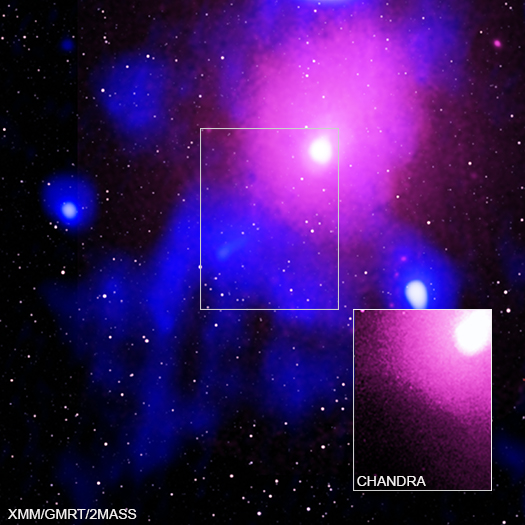
Ophiuchus Galaxy Cluster
Credit: X-ray: Chandra: NASA/CXC/NRL/S. Giacintucci, et al., XMM-Newton: ESA/XMM-Newton;
Radio: NCRA/TIFR/GMRT; Infrared: 2MASS/UMass/IPAC-Caltech/NASA/NSF
We are pleased to welcome two guest bloggers, Maxim Markevitch and Simona Giacintucci, who led the study described in our latest press release. Markevitch, an expert on galaxy clusters X-ray studies, got his PhD at the Space Research Institute of the Russian Academy of Sciences. He worked on ASCA X-ray data in Japan, then at the Chandra X-ray Center for the first 10 years of Chandra operations, and is now at the NASA Goddard Space Flight Center. He received the AAS Rossi Prize. Giacintucci, the lead author of the study, is an expert in radio phenomena in galaxy clusters. She got her PhD at Bologna University. She was a postdoc at the CfA and an Einstein fellow at the University of Maryland, and is now at the Naval Research Lab.
Galaxy clusters are colossal concentrations of dark matter, galaxies, and tenuous, 100-million-degree plasma. This plasma — gas where the electrons have been stripped from their atoms — slowly loses heat by emitting radiation in the form of X-rays. Around the central peaks of many clusters, where matter concentrates, the plasma gets dense enough* to cool quite fast, on a timescale shorter than the cluster's lifetime (a few billion years). The higher the plasma's density, the more X-rays it emits and the faster it cools. As it cools down, it contracts and becomes denser still, and so on, entering a runaway cooling process. Left unchecked, this process should deposit vast quantities of cold gas in the cluster centers.
We know for a fact that the plasma cools down because we do observe those X-rays — but we don't find nearly as much cold gas in the cluster centers as such runaway cooling must deposit. This has been a puzzle for a long while, and the solution the astronomers converged upon is that there must be some source of additional heat in the central regions of clusters — their “cores” — that doesn't let the plasma cool below 10 million degrees or so.
Early Chandra X-ray images of galaxy clusters pointed to the likely source: the supermassive black holes (SMBH) that sit in the centers of the cluster central galaxies, pull in the surrounding matter, and eject a tiny part of it (just before it sinks irretrievably into the black hole) at nearly the speed of light back into the surrounding gas. Where those jets hit the gas, they blow huge bubbles in it, stir it, generate shocks like sonic booms, etc. (all of these features have been seen in the Chandra images of the cluster cores). The current wisdom holds that these processes together supply the needed heat to prevent runaway cooling from occurring, but at the same time are not so powerful that they blow up the whole plasma cloud, implying some kind of a gentle, self-regulated feedback loop may be occurring.
Famous Black Hole Has Jet Pushing Cosmic Speed Limit
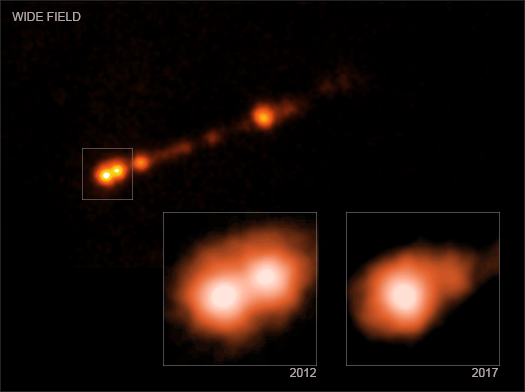
Supermassive Black Hole Jet in M87
Credit: NASA/CXC/SAO/B.Snios et al.
These images show evidence from NASA's Chandra X-ray Observatory that the black hole in the galaxy Messier 87 (M87) is blasting particles out at over 99% the speed of light, as described in our latest press release. While astronomers have observed features in the M87 jet blasting away from its black hole this quickly at radio and optical wavelengths for many years, this provides the strongest evidence yet that actual particles are travelling this fast. Astronomers required the sharp X-ray vision from Chandra in order to make these precise measurements.
The main panel of the graphic shows the entire length of M87's jet seen by Chandra, stretching for about 18,000 light years. "Knots" of X-ray emission seen here are created when material falls onto the M87 sporadically, creating bursts of X-ray light that travel along the jet and away from the black hole. The insets show Chandra observations taken in 2012 and 2017 of a small region near the base of the jet. The source in the lower left is X-ray emission from material around the black hole, and the other source is a knot in the jet about 900 light years from the black hole. This knot moves away from the black hole between 2012 and 2017 and also fades by 70%.


